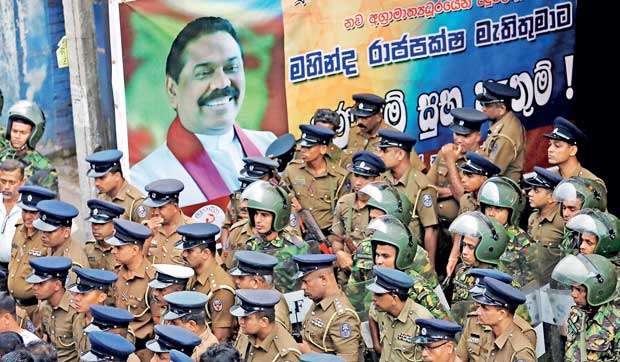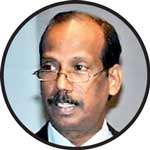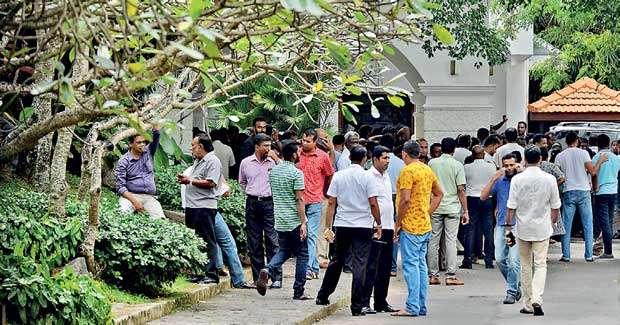Reply To:
Name - Reply Comment
Last Updated : 2024-04-23 18:56:00
Legal experts form opinions on whether the removal of Ranil Wickremesinghe as Premier was constitutional or not

Members of Sri Lanka’s Special Task Force and the police stand guard next to a poster of newly appointed Prime Minister Mahinda Rajapaksa in front of the Ceylon Petroleum Corporation, in Colombo, Sri Lanka October 28, 2018. REUTERS/Dinuka Liyanawatte
 Last Friday (October 26), the country was taken by surprise when former President Mahinda Rajapaksa was sworn in as the new Prime Minister of Sri Lanka. The appointment was shrouded in secrecy and at the time of appointment Ranil Wickremesinghe hadn’t vacated office. Since there was no discussion, consultation or announcement of the President’s move before he made it, questions are raised and opinions are formed about this drastic change of Government and the head of state who played a major role in it.
Last Friday (October 26), the country was taken by surprise when former President Mahinda Rajapaksa was sworn in as the new Prime Minister of Sri Lanka. The appointment was shrouded in secrecy and at the time of appointment Ranil Wickremesinghe hadn’t vacated office. Since there was no discussion, consultation or announcement of the President’s move before he made it, questions are raised and opinions are formed about this drastic change of Government and the head of state who played a major role in it.
The citizenry of this country has only known of General Elections as the democratic avenue available to it to change a regime by exercising the right to vote. In view of the novelty of the circumstances and deep conundrum that the general public is left with, the Daily mirror inquired into the constitutionality of this controversial situation by consulting experts in the legal field. Their opinions were mainly twofold.
According to one group of the legal experts the Daily mirror spoke to, the present appointment becomes constitutional only when the Cabinet of Ministers ceases to function under the provisions in the Constitution and when the Prime Minister has lost confidence of the Parliament. They maintain that in the present instance, since the Parliament was not consulted, the purported removal is unconstitutional.
Some other legal experts point out that Article 46 (4) implies that when the National Government ceases to exist, there cannot be a Cabinet with over 30 ministers, and therefore the Cabinet stands dissolved. They contend that this warrants the removal of the Prime Minister. The counter-argument is that the provision in question only requires that the number of Cabinet ministers be reduced to 30 and not the dissolving of the Cabinet. It is further argued that the end of the National Government isn’t a ground for the dissolution of the Cabinet as per the Constitution.
With uncertainty looming over who is now the Prime Minister, Parliament has been prorogued until November 16 in an evidently undemocratic move as pointed out in the following extracts:
Appointment of MR as PM is unconstitutional

“Blatantly undemocratic to keep proroguing Parliament.”
Arguing that Rajapaksa’s appointment was unconstitutional, Attorney-at-Law Luwie Niranjan Ganeshathasan said, “There can be only one Prime Minister at any given time, so for a new appointment to take place the one holding office must be removed in a manner provided by the Constitution. Article 42 of the Constitution gives the President the power to appoint a Prime Minister only when there is a vacancy. Article 42 doesn’t give the President the power to remove a sitting Prime Minister”.
PM to be removed only by Parliament
“The Prime Minister can only be removed by Parliament and Articles 46 and 48 of the Constitution make this clear. It should specifically be kept in mind that the 19th Amendment removed an explicit provision in the 1978 Constitution which allowed the President to remove the Prime Minister at his discretion,” he added.
Dismissing the argument that the UPFA withdrawing from the coalition Government justifies the appointment of a new Prime Minister he stressed on the importance of considering the constitutional impact of the UPFA deciding to leave the National Government. “The National Government between the UNF and the UPFA got constitutional legitimacy through a Parliamentary resolution, therefore there has to be a Parliamentary process by which the National Government stops being relevant for the purpose of the Constitution,” he said.
Cabinet not dissolved
“The constitutional implication of the National Government between the UPFA and UNF ending is that the number of Members of the Cabinet of Ministers has to be reduced. This does not automatically mean that the entire Cabinet of Ministers ceases to exist. Changes to the members of the Cabinet of ministers doesn’t mean that the entire Cabinet of ministers ceases to exist. The situations in which the Cabinet of ministers will be dissolved are clearly mentioned in Article 48 (2) of the Constitution. The dissolution of the National Government is not one of them,” he said.
Undemocratic to prorogue Parliament
“This entire process has led to much instability in the country and right now we have two Governments. The situation has to be clarified as soon as possible. The only way to do this is by summoning Parliament and seeing who has the majority. This has to happen immediately. It is blatantly undemocratic to keep proroguing Parliament till the President’s side can coerce a majority,” he said.
Asked how the new appointment should have been made, Ganeshathasan said that the Prime Minister should have been removed by Parliament before the President appointed the new Premier. “This could have happened either by Parliament rejecting the Statement of Government Policy, Parliament defeating the Budget or Parliament passing a vote of no-confidence in the Government,” he said.
“On the night of October 26, 2018 for the first time since Independence, Sri Lanka had a situation where Government power was being transferred in a manner that was clearly against the Constitution and against the idea of a peaceful transfer of power. Regardless of our political affiliations or ideologies as citizens of the country we should be very concerned about this. It is hard to imagine that a process like this will be good in the long-term health of democracy,” he added.

“That is not how democracy functions”
Constitutional Law expert Dr. Nihal Jayawickrama said that prior to the 19th Amendment, Article 47 (a) empowered the President to remove the Prime Minister from office. “That Article was repealed. The new Article 46 now states that the Prime Minister continues in office unless (i) he resigns, or (ii) he ceases to be a Member of Parliament,” he said.
General rule of interpretation in Interpretation Ordinance (IO) does not apply to Constitution
“However, the power to remove the Prime Minister may be claimed from two other sources. One is section 14 of the Interpretation Ordinance which states that “In all enactments, for the purpose of conferring power to dismiss, suspend, or to reinstate any officer, it shall be deemed to have been and to be sufficient to confer power to appoint him”. This is a general rule of interpretation and will not apply to a law, including the Constitution, in which the power to dismiss is specifically granted or removed.”
“The other source is the new Article 47(2) of the Constitution which states that “Notwithstanding the death, removal from office or resignation of the Prime Minister during the period intervening between the dissolution of Parliament and the conclusion of the General Election, the Cabinet of Ministers shall continue to function . . .”. We do not know why reference was made in this Article to the “removal from office” of the Prime when the previous new Article 46 expressly omitted the power to remove him. Perhaps it was faulty drafting. Perhaps it was intended that the President should have the power to remove the Prime Minister at any time after the dissolution of Parliament when the question of enjoying the confidence of Parliament no longer arises,” he said.
No-Confidence motion survived
“Article 42 (3) requires the President to appoint as Prime Minister the Member of Parliament who, in his opinion, is most likely to command the confidence of Parliament. This power is usually exercised following a General Election. In August 2015, Ranil Wickremasinghe was appointed Prime Minister because the UNP (or UNF) had secured the highest number of seats. More recently, he survived a no-confidence motion with an absolute majority of Members voting for him. How then can the President now claim that Ranil Wickremasinghe no longer enjoys the confidence of Parliament?”
He questioned as to whether the President has violated the Constitution. “Can he remove the incumbent Prime Minister without any evidence whatsoever that he no longer enjoys the confidence of Parliament? Can he, by proroguing Parliament, prevent Parliament from expressing its confidence either in the incumbent Prime Minister or in the Member he has purported to appoint to that office? That is not how democracy, which is the fundamental basis of our Constitution, functions.,” he said.

“President has no discretion to remove Premier”
V.T. Thamilmaran, Senior lecturer at the Faculty of Law, University of Colombo asserted that the President does not have the discretion to remove the Premier. “In any case discretionary power cannot go against the very purpose of the crafters of the 19th Amendment. The circumstances which warrant the removal of the Prime Minister are clearly spelt out in the Constitution after the 19th Amendment,” he said.
Addressing the argument that if the President can appoint the Prime Minister he can remove him, he said that that was so under the original text prior to the 19th Amendment. “Are you going to say it is still the same? Then what is the purpose of this amendment?”
“You can argue that no where is it stated that the President cannot remove the Prime Minister. But his is not so because the original text in Article 47 (a) specifically said President can remove, but now it is no longer there,” he explained.
He said the President should have asked the UPFA or JO to bring a no-confidence motion in Parliament. “This is not about President exercising his power. It is about Parliamentary democracy. Therefore, it is for the opposition party in Parliament to bring a no confidence motion and test it,” he said.
When asked about the argument that when the UPFA leaves the Government the cabinet stands dissolved, Thamilmaran said there was no such provision in the Constitution. “Article 46 (4) is applicable only when deciding the number of ministers and to nothing else. It has nothing to do with the removal of Prime Minister or the powers of the President,” he said.
“There is a maxim in law, that if you’re prevented from doing something directly you are prevented from doing it indirectly as well. So by asking another person to take oaths as Prime Minister you are removing the existing Prime Minister which is prevented by the law from being done directly,” he said.
Constitutionality can be challenged in SC
“There is now a proviso attached to Article 35 which deals with Presidential immunity under 19A. There is now no immunity with respect of anything done or omitted to be done by the President, in his official capacity. So an application can be made under Article 126. There is a clear case that any citizen of this country can go to the Supreme Court under Article 126 based on franchise and fundamental rights,” he said.
Who is the PM?
Responding to the question as to who the Prime Minister is now, Thamilmaran said that Kelson’s Theory should be considered. “The President is the Commander-in-Chief and is in a position to control. So according to this theory the President can appoint someone. But the Constitution restricts this power. Just because the appointment is undemocratic it doesn’t mean the President doesn’t have the power,” he said stressing that the President has used his powers undemocratically.

The President must form the opinion whether another MP commands confidence of Parliament”
Mr. Gunatilleke, Research Director of Verite Research, claims that the purported removal of Ranil Wickremesinghe is completely unconstitutional, and unambiguously undemocratic. He identified that the Prime Minister’s removal in the present case has to satisfy two conditions; first, the Cabinet of Ministers must cease to function under the provisions of the Constitution as provided by Article 46 (2) of the Constitution and second, the Prime Minister must lose confidence of the Parliament as provided by Article 42(4).
Cabinet of Ministers must cease to function to remove PM
Speaking of the first instance, Gunatilleke emphasised that the word ‘shall’ used in Article 46(2) indicates that it is constitutionally mandated that the Prime Minister cannot be removed unilaterally by any person including the President, unless the instances provided by the two exceptions to this rule are satisfied (which are: if he resigns; or ceases to be a Member of Parliament). “Since we know the Prime Minister has neither resigned nor ceased to be an MP, the Cabinet of Ministers must cease to function in order for it to be possible for the Prime Minister to be removed”
Parliament must lose confidence in PM to remove him
Regarding the second condition, Gunatilleke stated that although when appointing the Prime Minister, the President is mandated by the Constitution to appoint a Member of Parliament who in the President’s opinion is most likely to command the confidence of the Parliament, the Cabinet of Ministers ceasing to function is not a sufficient condition to remove the Prime Minister, although it’s a necessary condition in the present case. He stated that the President must then form the opinion as to whether another Member of Parliament is more likely to command the confidence of the Parliament and that this opinion cannot be unreasonable and should be confirmed by the Parliament.
“It is disputed whether the first condition, which is that Cabinet of Ministers ceased to function, was in fact met. It is however obvious that the second condition, which is that the Parliament losing its confidence in the Prime Minister has not been met, as Parliament has been prorogued, and deliberately prevented from confirming or denying the President’s opinion. This is an abuse of power under the Constitution.”
Appointment of MR as PM is constitutional

“Appointment and removal of PM is exclusively within the domain of the President”
Constitutional lawyer Chrishmal Warnasuriya pointed out that when the UPFA moved out of the National Government on Friday, the National Government consisting of the Prime Minister and the Cabinet formed under Article 46 (4) no longer existed. “When communication has been made that they are no longer part of the National Government, then the present cabinet stands dissolved,” he said.
When pointed out that there are no constitutional provisions stating that the Cabinet dissolves under such a circumstance, he questioned as to whether there were provisions in the Constitution stating the contrary- that the Cabinet was not dissolved. “A Government comprises an Executive President who commands Executive Power together with the Cabinet of ministers of which the Prime Minister is a member. Article 46 (2) states that the “Prime Minister shall continue to hold office throughout the period during which the Cabinet of Ministers continues to function.” So when the cabinet goes out the Prime Minister goes out,” he said.
“Then under Article 42 (4) the President shall appoint as Prime Minister the Member of Parliament who, in the President’s opinion, is most likely to command the confidence of Parliament. He further explained that “confidence of Parliament” is subjective. “If the President thinks that the man with the loudest voice can command the Parliament, that’s his opinion. The Constitution doesn’t say anywhere how that confidence is measured,” he said.
“According to my interpretation the appointment and removal of the Prime Minister is exclusively within the domain of the President. There is nothing in the constitution which says that its dependent on numbers of heads of Parliament,” he added.

“What matters is President’s opinion about whether PM commands confidence of Parliament
Manohara De Silva, PC on the other hand stated boldly that the matter was perfectly constitutional. According to him, the moment UPFA walked out of the coalition, the National Government ceased to exist and therefore there cannot be a constitutional Cabinet of Ministers with over 30 Cabinet of Ministers.
President can change Cabinet at any time
“Given the breakdown of the National Government, the only way to have a Constitutional Government and Cabinet of Ministers is for the President to change the composition of the Cabinet of Ministers, which he is empowered to do at any given time under Article 43(3) of the Constitution.”
English Translation of the Constitution is incorrect
He pointed out that as per article 42 (4) of the Constitution, it is the President’s opinion as to whether the Prime Minister commands the confidence of the Parliament that matters. He further stated that certain people have only read the English Translation of the Constitution which is incorrect; if the Sinhala Version is referred to, they will see that the Prime Minister can be removed according to Article 48(1).

“Parliament can now remove MR if there is no confidence in him”
A similar view was held by M.U.M. Ali Sabry, P.C as he also asserted that the removal of Ranil Wickremesinghe and appointment of Mahinda Rajapaksa to the office of Prime Minister was constitutional.
If no National Government, no Cabinet warrants removal of PM
He stated that under the Sri Lankan Constitution, a Government is formed under Article 42, according to which a Cabinet of Ministers and a Prime Minister needs to be appointed. He added that according to Article 46 (5), the Parliament can decide the number in the Cabinet of Ministers if a National Government is formed. He recalled how a National Government was formed in this country on the basis of 2 letters submitted by UNP and UPFA. Now that one of the constituent parties of the National Government – the UPFA has withdrawn its support, Sabry claims that there is no National Government.
“If the National Government is no more, that means there is no Government. Then a new Government needs to be established. About what happens to the Prime Minister in this situation is clearly addressed by Article 46 (2) of the Constitution, which states that the Prime Minister shall continue to hold office during which the Cabinet of Ministers continues to function. Therefore when the National Government ceases to exist, the Cabinet, which was appointed premised on the National Government is no longer valid and thus by that very fact, the Prime Minister ceases to hold office.”

Up to MR to show confidence of Parliament
Regarding the appointment of Mahinda Rajapaksa to the office of the Prime Minister, Sabry claimed that it is also completely constitutional because the President is vested with the power to appoint whoever in his opinion is the Member of Parliament that can secure the confidence of the Parliament as the Prime Minister under Article 42 (4).
“It is up to the newly appointed Prime Minister to then go to the Parliament and show his numbers. The President has done his part and acted constitutionally. Now if the Parliament decides that their confidence doesn’t rest with the appointed Prime Minister, then a no confidence motion can be brought to remove him.”
Kumar Tuesday, 30 October 2018 09:17 PM
It is clear that Sri Lankans don't need anybody from out side to make things worse than what it is. Best to get rid of the abuser soon.

Add comment
Comments will be edited (grammar, spelling and slang) and authorized at the discretion of Daily Mirror online. The website also has the right not to publish selected comments.
Reply To:
Name - Reply Comment
On March 26, a couple arriving from Thailand was arrested with 88 live animal
According to villagers from Naula-Moragolla out of 105 families 80 can afford
Is the situation in Sri Lanka so grim that locals harbour hope that they coul
A recent post on social media revealed that three purple-faced langurs near t